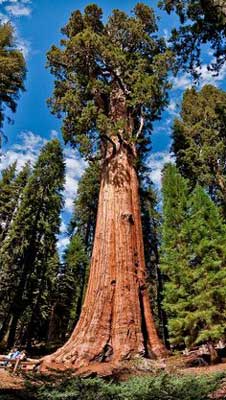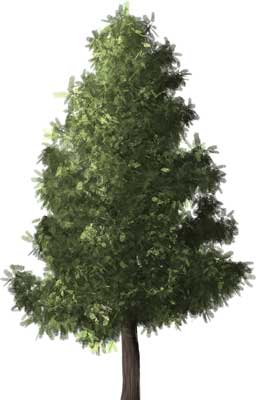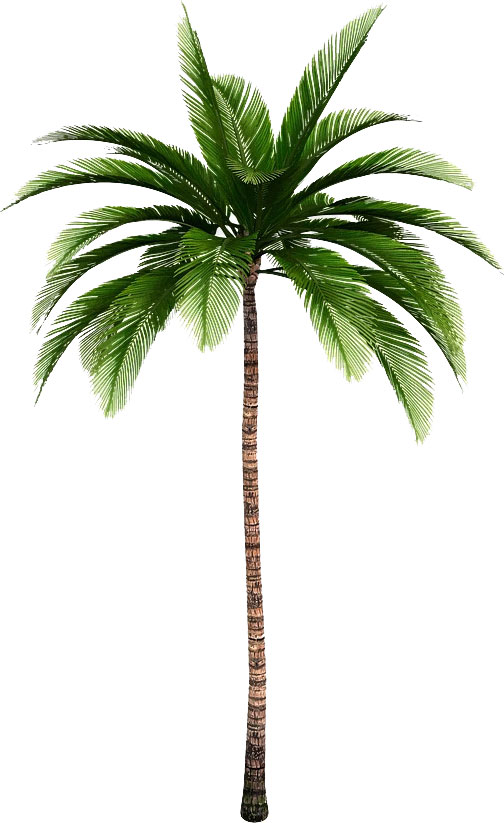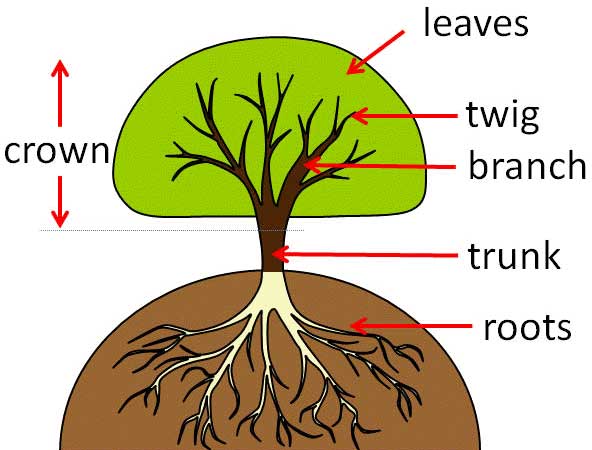Trees are one of the most useful and beautiful plants on the Earth. They provide us with fresh oxygen and many necessary things, e.g. wood, fruits, pulp for producing paper, and shade on sunny days. Also, they provide homes to a lot of animals including land animals, insects, and birds.
What is a Tree?
Trees are plants, which look bigger with lots of branches and leaves. There is no proper scientific definition of tress. In general, a plant is considered a tree if its height reaches more than 13 feet, lives for many years, and has a woody stem. Moreover, there are certain features which are common in trees. These features are:
- They can grow in the vertical direction.
- They have a single main trunk
- The trunks of a tree are mostly covered with bark for protection of their inner tissues.
- They have many branches emerging from a single trunk. Also, the branches are covered with leaves.
Types of Trees
Trees are very diverse plants that are spread around the world. There are more than 73,000 discovered species of trees. Most of the trees can be categorized into four main types according to their leaves.
- Coniferous Trees (Conifers)
- Evergreen Trees
- Deciduous Trees
- Palm Trees
Coniferous Trees (Conifers)

Conifers are mostly known for their scale-like and needle-like leaves which are mostly found in cold climates. Conifers don’t produce flowers for reproduction, but they produce cones for this purpose. These trees belong to a larger group called gymnosperms. Some of the famous conifers are redwoods, cedar trees, and spruce trees.
Evergreen Trees

Evergreen trees, as the name suggests, remain green during all seasons. They don’t shed their leaves completely in the autumn. Evergreen trees have continuous foliage; they grow new leaves that replace the older ones. Also, they release oxygen year-round due to photosynthesis taking place in all seasons. Conifers are also part of evergreen trees because they remain green year-round. Examples of the evergreen trees redwoods, pines, cypresses.
Deciduous Trees

Deciduous trees are known to lose all of their leaves during autumn and remain bare throughout the winter. They grow new leaves each year, unlike the evergreen trees which don’t lose all of their leaves at once. The color of deciduous trees also changes in the autumn. Examples of deciduous trees are beeches, maples, and oaks.
Palm Trees
 Palm trees are a very distinct group of trees that are mostly found in tropical and subtropical regions. They have a unique appearance and are mostly characterized by their tall branchless trunks. They have a big crown of large feather-like leaves on their top. There is a large variety of palm trees, but the most famous are coconut palm trees and date palm trees. Palm trees also play an important part in the economy due to palm oil which contributes a significant percentage of worldwide edible oils.
Palm trees are a very distinct group of trees that are mostly found in tropical and subtropical regions. They have a unique appearance and are mostly characterized by their tall branchless trunks. They have a big crown of large feather-like leaves on their top. There is a large variety of palm trees, but the most famous are coconut palm trees and date palm trees. Palm trees also play an important part in the economy due to palm oil which contributes a significant percentage of worldwide edible oils.
Structure of a Tree
 Trees, like any other plant, are structurally interconnected systems to perform vital functions for survival. The main parts of a tree are:
Trees, like any other plant, are structurally interconnected systems to perform vital functions for survival. The main parts of a tree are:
- Roots: Roots are part of the trees which remain in the soil. They absorb the water and nutrients from the soil for the whole tree. Also, they provide a strong anchor to hold the trees in strong winds.
- Trunk: A trunk provides support and shape to all the parts of a tree. It stores and transports water, nutrients, and food to all of its parts.
- Crown: The crown is the topmost part of a tree and is made of branches, sub-branches, leaves, and reproductive parts. The overall appearance of a tree is represented by this structure. It has different shapes and sizes for different trees.
- Branches: Branches emerge from the main trunk of a tree for the distribution of leaves in large spaces evenly. They grow at different heights of a tree so that leaves can get the necessary air and sunshine.
- Leaves: They are like the food factories for a tree. They produce food in the photosynthesis process and give precious oxygen to animals and humans. Leaves contain a substance called chlorophyll, which gives them a green color and is used in photosynthesis.
Trees and Humans

Trees are giving us food, wood, and many other necessary materials. They provide us with fresh oxygen and help to reduce the pollution. But, we as a human are destroying the trees for the land and wood.
The number of trees across the world is decreasing sharply. A lot of forests have been destroyed for land and agriculture. As a result, many animals have become endangered species and air pollution has increased.
We must understand the fact that trees are an important part of our ecosystem. They help us in many ways and make our Earth a place to live. We should treat the trees with proper care. If you can, try to plant as many trees as possible around your home. Also, explain to others about the importance of trees.
Fun Facts
- Trees use carbon dioxide to produce food. A single tree can consume about 21 kg (48 pounds) of carbon dioxide each year.
- Trees excrete water from their leaves which evaporates. As a result, the temperature of its surroundings is reduced.
- Trees work as filters for the rainwater.






